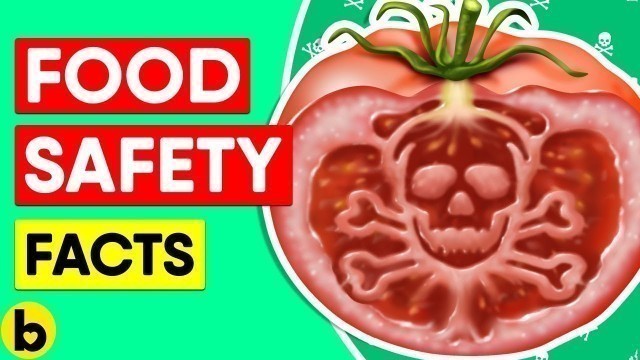

'Here are 17 food safety facts you should know! These food safety tips given by the USDA and other food inspection organizations will help you steer clear of food poisoning in the future when you forget what temperature your fridge should always be at. #FoodSafety #Food #FoodService Timestamps: Intro - 0:00 1. Refrigeration: 1:56 2. More Fridge Stuff: 2:14 3. Fresh Meat: 2:41 4. Canned Foods: 3:06 5. Room Temperature: 3:29 6. Frozen Eggs: 3:57 7. Frozen Dinners:4:19 8. Chocolate: 4:34 9. Melons: 4:56 10. Freezing: 5:23 11. Turkey: 5:49 12. Fruits And Veggies: 6:22 13. Left Overs: 7:07 14. Barbeque: 7:39 15. Cans Or Jars: 8:18 16. Can Openers: 8:45 17. Mold: 9:38 Music: https://www.youtube.com/audiolibrary/music Summary: 1. Refrigeration. Always refrigerate your perishable items within 2 hours. It goes down to 1 hour when the temperature outside is above 90°F (32.2ºC). 2. More Fridge Stuff. Be sure to check the actual temperature of your fridge with an appliance thermometer. Your fridge could be broken and you don’t even know it. 3. Fresh Meat. When you eat fresh meat (poultry, fish, ground meat, or variety) and keep it in the fridge make sure you cook it within 2 days or put it in the freezer if you still haven’t cooked it after the second day. 4. Canned Foods. Discard any of your canned foods that have dents, or swollen containers. These are usually good indefinitely but can go bad if exposed to freezing temperatures or temperatures above 90 °F. 5. Room Temperature. Always discard any food that has been left out at room temperature for more than 2 hours. This changes to 1 hour if the temperature was above 90°F. 6. Frozen Eggs. If you want to freeze your eggs, crack them first then freeze. Freshly cracked eggs will only last 2 to 4 days in your fridge but they will last up to a year in your freezer. 7. Frozen Dinners. If you’re into frozen dinners, you can keep those in your freezer up to 3 to 4 months. Do not keep them in the fridge; they aren’t meant to be there and they will harbor bacteria. 8. Chocolate. Ever seen that white film on chocolate? Yeah, apparently that’s not too big of an issue. It just means that fat has deposited on the front of the chocolate bar, but considering we all know how fattening chocolate already is that’s not too much of a deterrent! 9. Melons. Let\'s talk about food safety in relation to melons for a second. Did you know that it takes four hours for bacteria on melons to start multiplying? So if you\'re enjoying the aforementioned melon in the hot summer sun, make sure to eat it all up before four hours goes by! Who are we kidding, we didn\'t have to tell you that, did we? 10. Freezing. We\'ve talked a lot about freezing stuff in this video, so we should probably give you the most important piece of information about the practice. Keep this in mind when you stick food in the freezer: freezing only stops the growth of bacteria but it doesn’t kill it. 11. Turkey. This is for all the people who celebrate Thanksgiving, or maybe just every one who enjoys some of that delectable big bird from time to time. When you\'re done basting and seasoning your turkey and leave it be, keep this in mind: It is harmful for a raw turkey to be kept non-refrigerated for more than 45 minutes. 12. Fruits And Veggies. Next, we learn about some food safety when it comes to everyone\'s favorite food group: fruits and vegetables. Here\'s a great tip for all those chefs out there who like to make a meal that doesn\'t come out of a cardboard, microwavable box: \"It is wrong to place your fruits and vegetables in the same bag with meats; it could lead to contamination.\" 13. Left Overs. Sometimes left overs can be awesome, sometimes they can stink. It really depends on the chef, your fridge and where you\'ve put them. But keep this in mind: Leftovers that have remained in the refrigerator should be re-cooked after more than 36 hours. 14. Barbeque. So you\'re out in the sun, enjoying your hopefully bacteria free melon, and you decide to have a barbeque. Why not? It\'s a beautiful day out, there\'s never been a better excuse to slap some meat on the ol\' BBQ and make some nice, smokey food. 15. Cans Or Jars. Say you\'re out of plates (because you used them all up at the barbeque) and you want to eat some Alphaghetti. 16. Can Openers. Alright, so now that you\'ve found a bowel for your Alphaghetti, it\'s time to open up that sucker and pour it into your Alphaghetti receptacle. ---------------------------------------------------------------------------------------- Subscribe to Bestie : https://goo.gl/tUqro6 ---------------------------------------------------------------------------------------- Our Social Media: Facebook: https://www.facebook.com/bestieinc/ ---------------------------------------------------------------------------------------- Medical Disclaimer: https://pastebin.com/xLmigD6i'
Tags: eggs , healthy , Health , Food , chocolate , Safety , MEAT , Bestie , Bestie Videos , freezer , fridge , usda , Danger Zone , Department of Health , food service , food poisoning , food safety , foodborne illness , temperature , food education , food hygiene , food handling , health inspection , food safety test , food and hygiene , What is food safety and why is it important , Food Safety Facts That You Should Know , Food Safety Facts
See also:

















comments